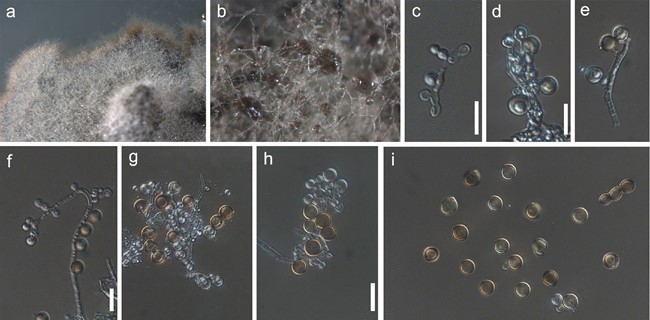Omania hydei Maharachch., Wanas. & Al‑Sadi, sp. nov.
MycoBank number: MB 837554; Index Fungorum number: IF 837554; Facesoffungi number: FoF 09483; Fig. 15
Etymology: Named in honour of British mycologist K.D. Hyde, for his huge contributions to ascomycete taxonomy.
Saprobic on decaying, submerged Avicenia marina in marine habitats. Sexual morph: Not observed. Asexual morph: Conidiophores arising from basal cells, cylindrical, hyaline, forming conidia laterally and terminally, frequently aggregated into a brown stroma, septate, branched, up to 250 μm long, 2.5–5.0 μm wide. Conidiogenous cells 2.0–5.0 × 1.5–3.0 μm, integrated, ampulliform to subcylindrical, smooth to finely verruculose. Conidia 7.0–11.0 × 7.0–10.5 µm, (x̄ = 9.5 × 9.2 µm, n = 30), hyaline at immaturity, dark olivaceous-brown at maturity, smooth to verruculose, guttulate, globose to subglobose, thick-walled (0.3 − 1.0 µm wide), mostly solitary, rarely in short chains.
Culture characteristics—Colonies on the PDA were slow growing reaching 5 cm diam. in ten days, superficial to erumpent, dark brown to grey, with moderate aerial mycelium, undulate margin.
Material examined—OMAN, Muscat, Al Qurum, from dead root of Avicenia marina, 11.10.2017, SSN Maharachchikumbura & AM Al-Sadi H26 (SQU H-120, holotype), ex-type living culture = SQUCC 3026.
GenBank accession numbers: LSU: MW077155; SSU: MW077162; ITS: MW077146; TEF: MW075772; RPB2: MW276077.
Notes—Omania hydei, isolated from dead roots of Avicenia marina collected from the Al Qurum beach in Mus- cut, Oman, is clearly distinct from Halojullela in having an asexual morph that is not arthrinium-like. Halojulellaceae is sister to the monotypic marine family Ascocylin- dricaceae, which includes the type species Ascocylindrica marina Abdel-Wahab et al., collected from Saudi Arabian mangroves (Ariyawansa et al. 2015). Ascocylindrica marina is characterised by small ascomata, cylindrical asci and bi- celled dark brown to black ascospores (Ariyawansa et al. 2015). We were unable to compare the morph of Omania hydei with A. marina as O. hydei is only reported as the asexual form. Further fresh collections and DNA based sequence data are warranted to understand the exact phylogenetic relationship between these two families.

Fig. 15 Omania hydei (SQU H-120, holotype) a, b Colonies on PDA. c–h Conidiophores, conideogenous cells and conidia. i Conidia. Scale bars: c = 50 μm, d, f, h = 20 μm. Scale bar of d applies to e. Scale bar of f applies to g. Scale bar of h applies to i
